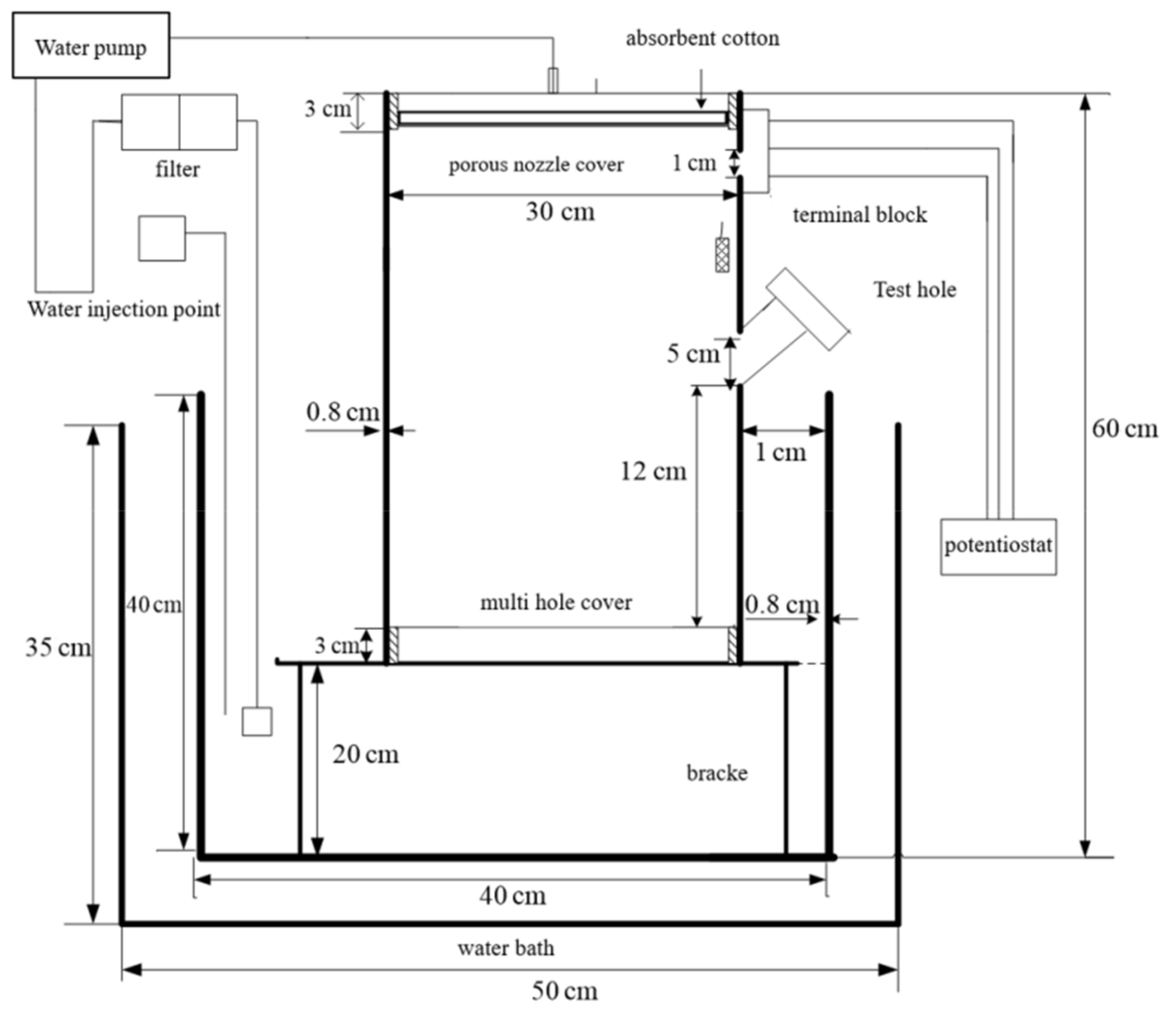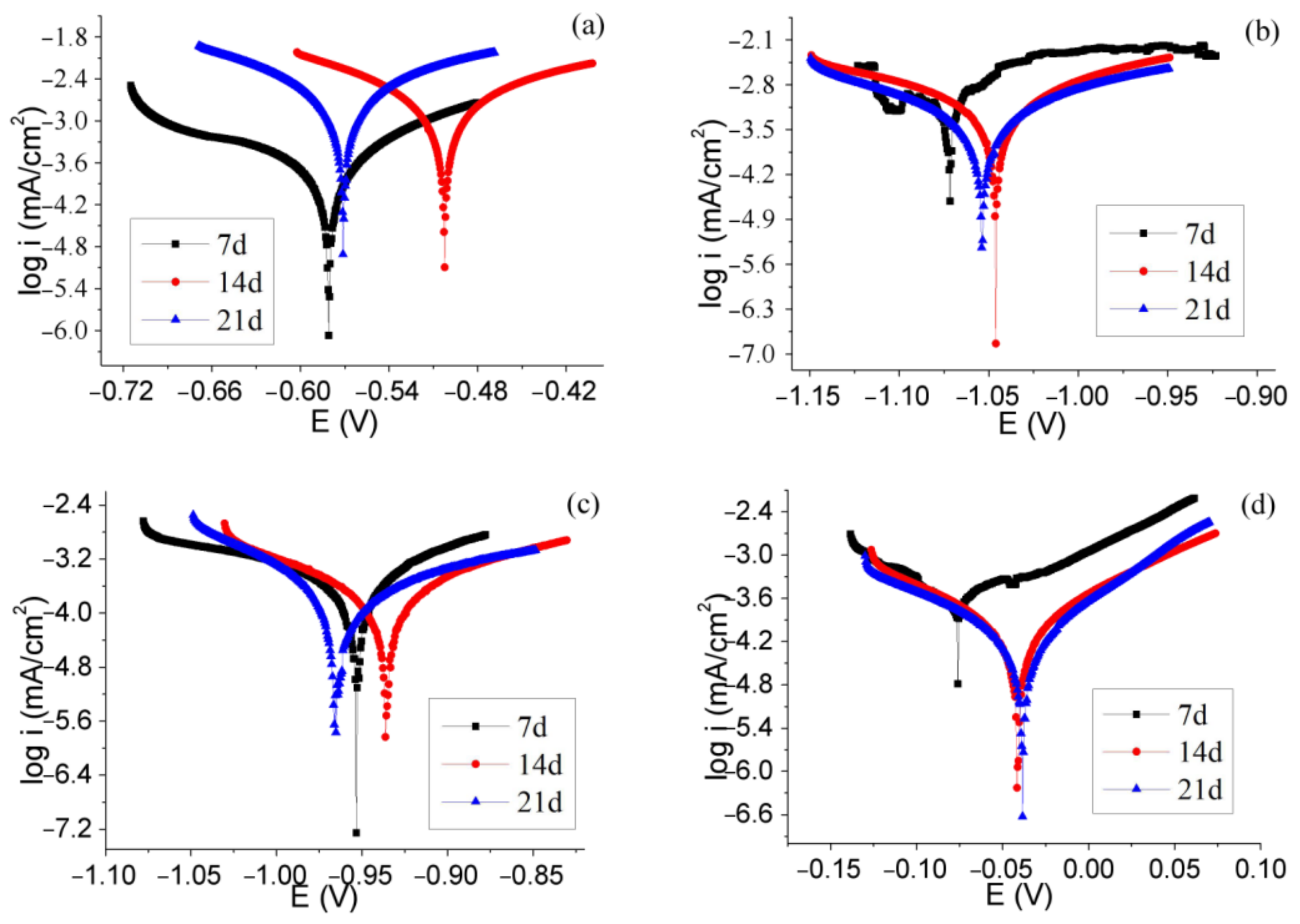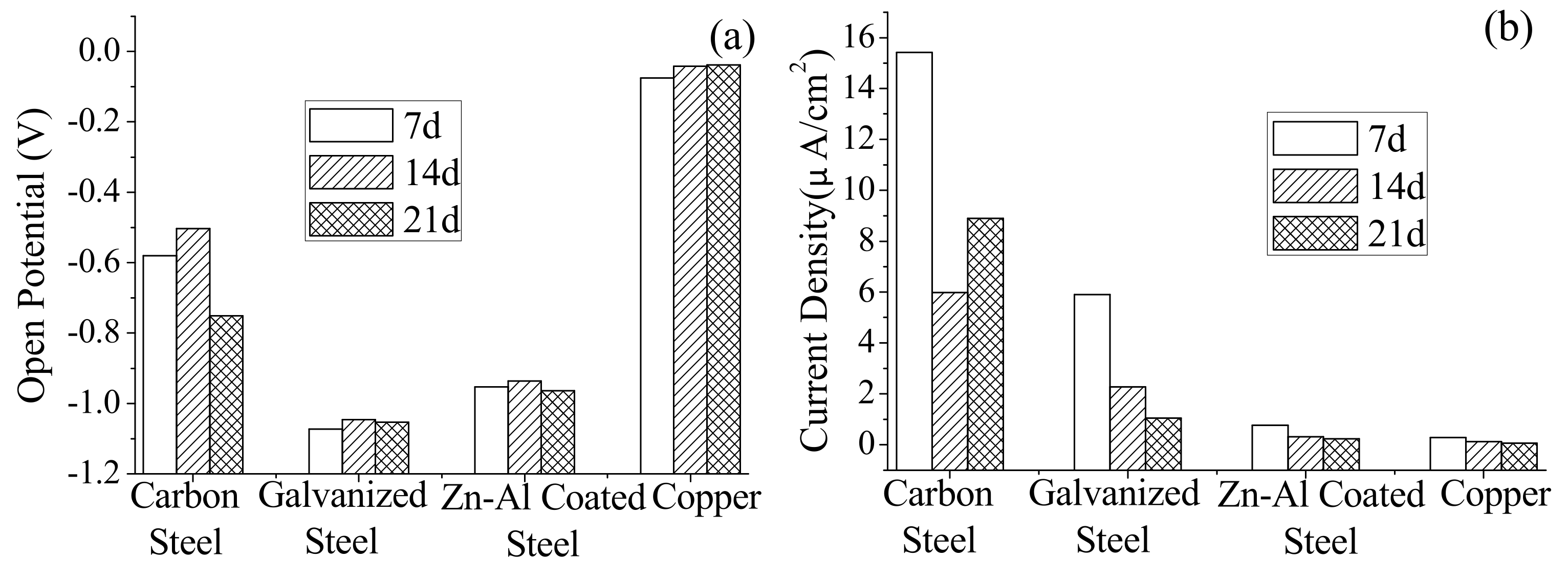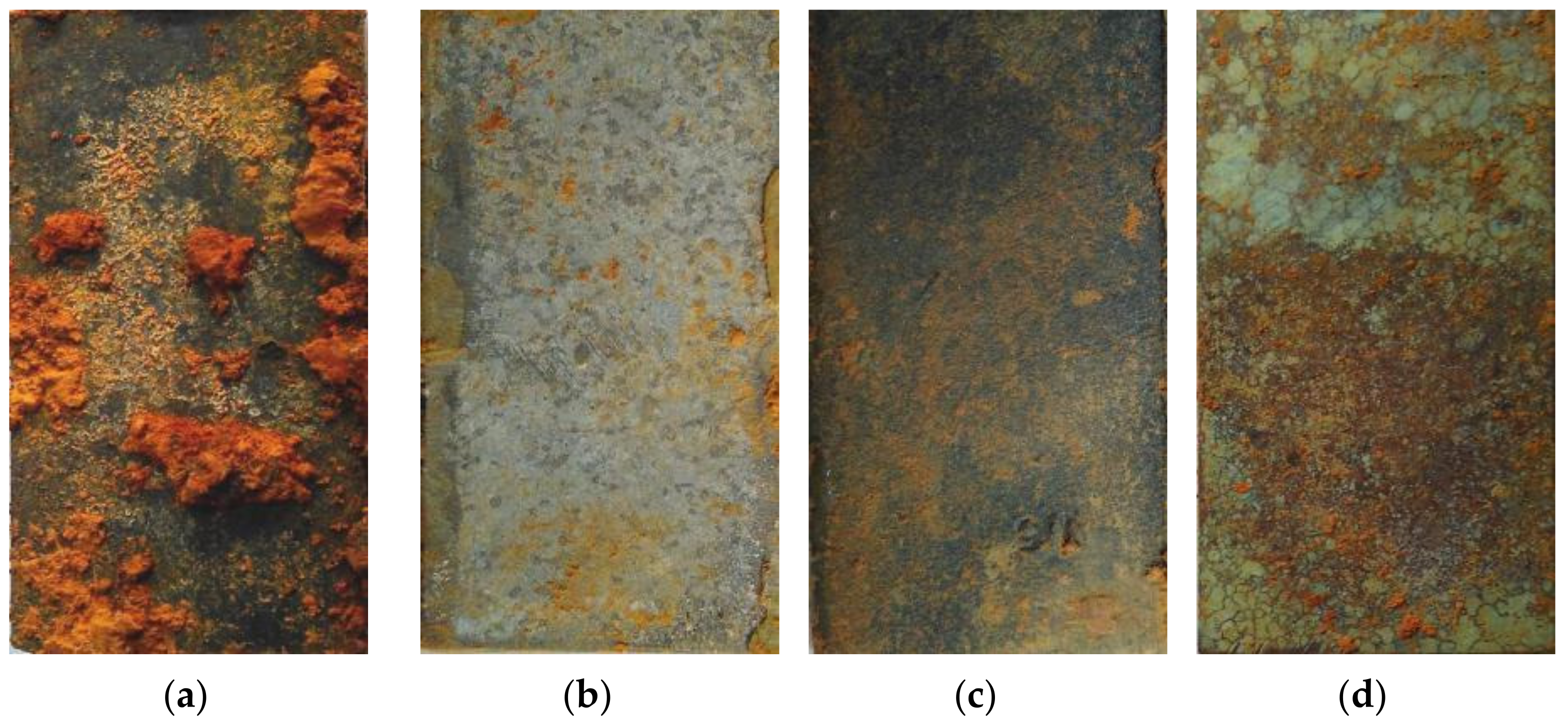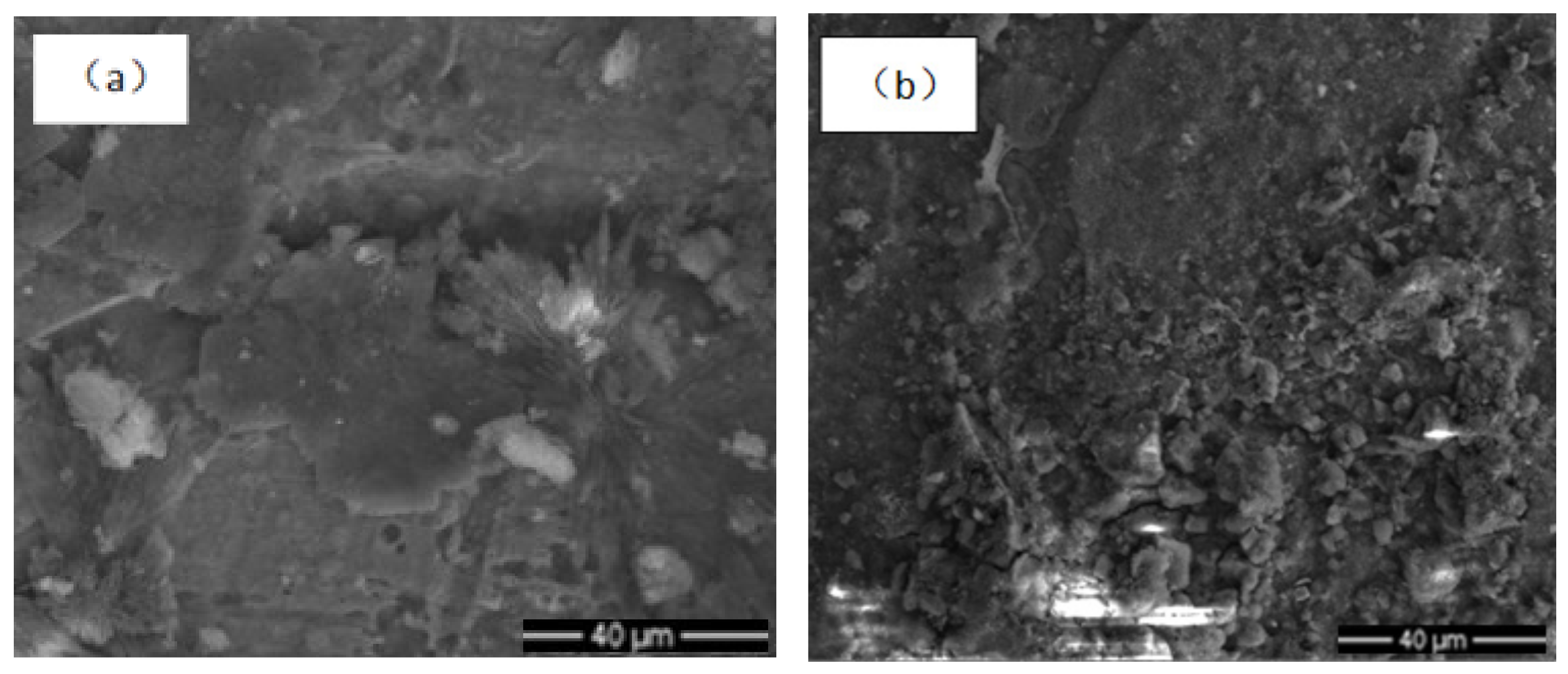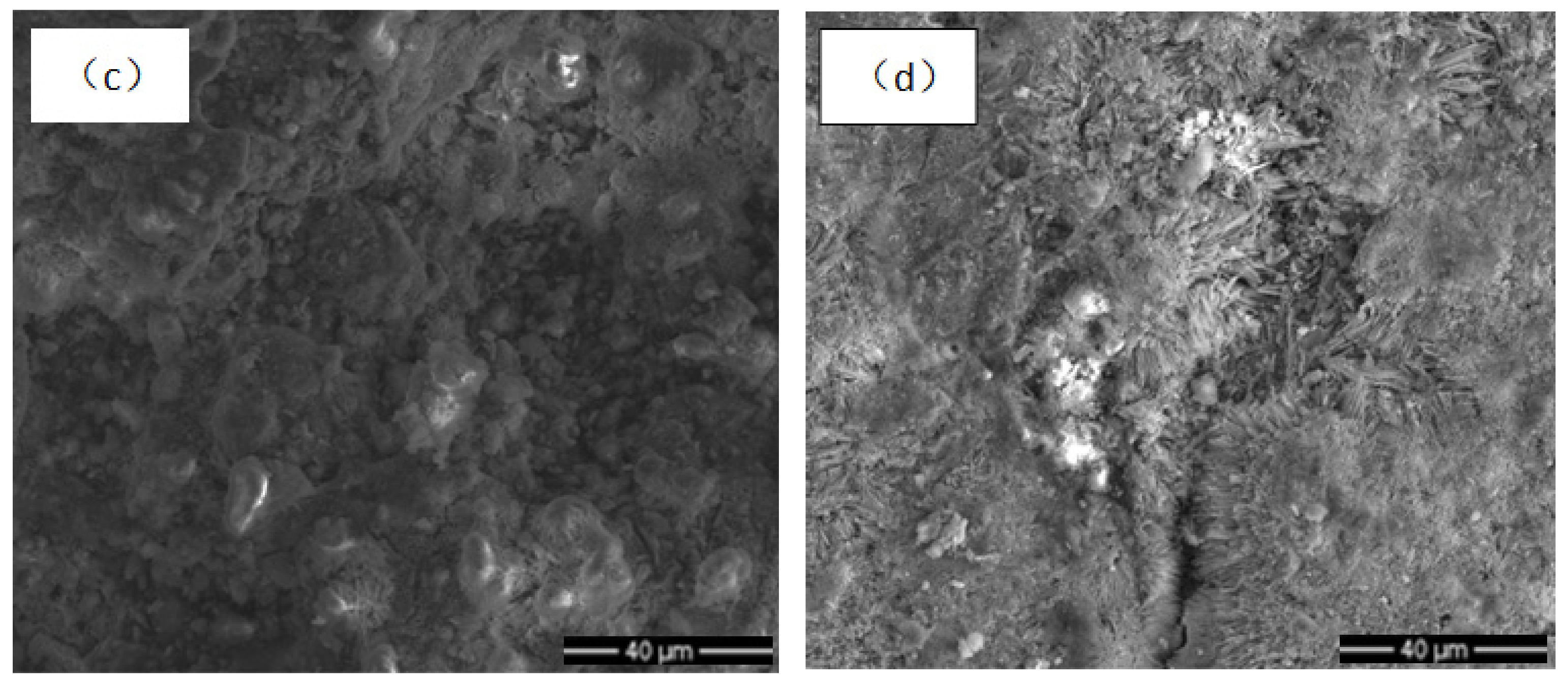1. Introduction
The grounding equipment is of great significance to ensure the safe operation of the power system. Some researchers have carried out research on grounding materials and grounding methods. D.K.J.S. Jayamah et al. studied Protection and grounding methods in DC microgrids [
1]. Weichen Yan et al. developed a cylinder Flexible Graphite Earth Electrode (FGEE) to reduce tower earth resistance [
2]. Zhanglong Zhang et al. investigated a fracture diagnosis method of grounding wire of tower grounding device [
3]. Haize Hu et al. designed a new substation grounding based on electrolytic cathodic protection and on transfer corrosion current [
4]. Junhui Zhao et al. studied acoustic-guided wave techniques for the detecting corrosion damage of electrical grounding rods [
5]. Zhipo Zhao et al. analyzed the microstructure and corrosion behavior of cold-sprayed Zn–Al composite coating [
6]. However, the grounding material works for long periods in the soil environment and grounding equipment is inevitably damaged by corrosion [
7,
8,
9,
10,
11,
12].
Corrosion studies on grounding materials were usually focused on carbon steel [
13]. Maocheng Yan, etc. [
14] found there were many iron oxides in the red soil, which can be used as the cathode depolarization agent to accelerate the corrosion. Wang Sen [
15] studied the corrosion behavior of H62 brass. Xu et al. [
16] studied the corrosion characteristics of Al coating, Al-Si alloy coating and Ni-Al alloy coating. Lin Bilan [
17] investigated the corrosion behavior of zinc and Zn15Al coating materials in Dagang soil. The corrosion resistance of Zn15Al coating is better. Vanessa DE Freitas Cunha Linus et al. [
18] studied the soil corrosion of X52 API carbon steel by the electrochemical method. The corrosion characteristics of different materials are also different [
19,
20]. The corrosion characteristics of carbon steel, galvanized steel, aluminum–zinc steel and copper were studied in the laboratory and in acid red soil. Red soil is a soil widely distributed in southern China, where the summer temperature exceeds 30 °C and the humidity exceeds 50, which is a typical acid soil environment.
2. Experimental
Carbon steel used to be the most commonly used grounding material due to its low cost. However, it has become increasingly unable to meet the performance requirements of grounding materials. In this experiment, Q235 carbon steel was selected as the base material, and the experimental sample was a steel sheet of 50 mm × 25 mm × 3 mm. The main components are shown in
Table 1.
With a Q235 carbon steel sheet as the base material, galvanized steel and zinc–aluminum alloy coated steel were prepared. Copper was also selected as the grounding material. The thickness of the zinc layer of galvanized steel is about 30 μm, and the thickness of the zinc–aluminum alloy coating is about 100 μm. A total of 110 samples of each grounding material were selected for experiment and field research. In order to better realize the accelerated corrosion research, the experimental temperature of the accelerated corrosion research in the laboratory was set to 60°, and corrosion medium was 20% moisture content red soil of the Qili substation (Ganzhou, China). The purpose of this accelerated experiment was to simulate the corrosion of grounding materials under the acid red soil on the ground. The schematic diagram of the device is shown in
Figure 1.
An electrochemical workstation (4000 PARSTAT, Shanghai, China) was used to test polarization curve by using the three-electrode system. The working electrodes were carbon steel, galvanized steel, Zn-Al coating steel and copper, respectively. The tops of them are welded and connected to copper wires, encapsulated by epoxy resin. The auxiliary electrode was platinum sheet, and the reference electrode was a sulfate saturated copper electrode. The scanning speed of the test was 0.5 mV/s, and scanning potential ranges from −100 to 100 mV were used. Those specimens were buried in the red soil for 10 months.
3. Results and Discussion
The polarization curve corrosion test of four grounding materials was carried out in the laboratory for 7 days (d), 14 days, and 21 days as shown in
Figure 2.
Figure 2 shows that, with the decrease in the scanning potential, the corrosion currents of grounding materials increase rapidly first, then the speed of increase slower, and finally the corrosion increases rapidly. At the beginning, the cathode surface is sufficiently supplied with oxygen and the reaction rate is fast. After a period of time, the oxygen potential shows a linear relationship with the logarithm of the current density, which is consistent with the Tafel formula. As the corrosion current density increases gradually, the oxygen on the cathode surface begins to be insufficiently supplied and is controlled by oxygen diffusion and the ion reaction, and the current density increases. Due to the slower oxygen diffusion rate, the oxygen content on the cathode surface is further reduced, the cathode polarization is intensified, and hydrogen evolution corrosion occurs, and the corrosion current density begins to increase sharply. Acid red soil has a higher hydrogen ion content and lower oxygen content, which aggravates the corrosion of grounding materials.
According to the results of the polarization curve (
Figure 2) above, the corrosion potential and corrosion current density of the grounding materials were fitted as shown in
Figure 3a,b.
The corrosion potential of the four materials is shown in
Figure 3a. It shows that the corrosion potential of the four materials is relatively stable. The corrosion potential of galvanized steel and Zn–Al steel coating is relatively low, and less than 0.9 V. The zinc layer is active in the soil and has the effect of a sacrificial anode protection cathode on the carbon steel substrate, which can prevent corrosion of pitting carbon steel. The Zn layer can form a dense oxide film on the surface, reducing the corrosion rate. The Zn–Al alloy coating formed a stable density compound on the surface. It reduces the area of the pure zinc phase improves the corrosion resistance. The activity of copper in the soil is lower than −0.1 V, but it shows good corrosion resistance.
The corrosion current density is shown in
Figure 3b. It shows that the corrosion current density of carbon steel was the highest. The galvanized steel is less than that of carbon steel. The corrosion current density of Zn–Al-coated steel and copper were very small. At the beginning, the corrosion current density of carbon steel was the highest, reaching 15.42 μA/cm
2. Then, it gradually decreased to 5.98 μA/cm
2; finally, it increased to 8.90 μA/cm
2 due to the peeling of corrosion products. The corrosion current density of galvanized steel is lower than that of carbon steel and only 5.90 μA/cm
2 at the beginning. Then, it is reduced to 1.04 μA/cm
2 due to surface passivation. The corrosion current density of Zn–Al coating steel is less than 1.00 μA/cm
2. Although copper has a low current density, it is discarded due to its high cost and environmental pollution. Therefore, Zn–Al-coated steel is the best grounding material.
Figure 4 shows optical micrographs of grounding materials in the red soil for 10 months.
Figure 4a shows that the surface corrosion of carbon steel is the most serious.
Figure 4b exhibits that the surface corrosion products of galvanized steel are reduced. Zn–Al-coated steel has the least surface corrosion as
Figure 4c. It is a potential grounding material.
Figure 4d shows that corrosion has obviously occurred on the copper surface. Nowadays, a high-power power system puts forward higher requirements on grounding materials in the service environment of acid red earth. Four typical grounding materials, carbon steel, galvanized steel, Zn–Al-coated steel and copper were investigated by the laboratory accelerated corrosion experiment and on-site field experiment, respectively. Carbon steel has the worst corrosion resistance in the acid red soil. The corrosion resistance of galvanized steel is improved. Although copper has good corrosion resistance, a large amount of copper ions cause soil heavy metal corrosion during long-term work. Zn–Al-coated steel shows good corrosion resistance in acid red soil. It shows good potential as grounding material.
SEM (SU1510, Hitachi Corporation, Tokyo, Japan) and XRD (D&ADVANCE, Bremen, Germany) of four grounding materials are shown in
Figure 5 and
Figure 6.
Figure 5a and
Figure 6a show the surface corrosion product of carbon steel. It indicated that there is a thick layer of corrosion products; the main components are Fe
3O
4A and FeO(OH). The remaining components are SiO
2 and CaCO
3, mainly from the attachment of symbiotic soil.
Figure 5b and
Figure 6b show that the main corrosion product of galvanized steel is ZnO, Zn
5(CO
3)
2(OH)
6, in which Zn
5(CO
3)
2(OH)
6 has a smooth and compact structure and uniformly covers the material.
Figure 5c and
Figure 6c show that the corrosion products of the Zn–Al-coated steel is mainly Al
2O
3 and Al
2ZnO
4.They are flocculent and closely packed and improve the corrosion resistance.
Figure 4d and
Figure 5d show that the surface corrosion product of copper is mainly Cu
2O, Cu
2(CO
3)(OH)
2. It is a needle-like corrosion product. The above analysis shows that the corrosion resistance of carbon steel is the worst. Zn–Al-coated steel has the best corrosion resistance. Corrosion weight loss rate of year is only 0.6606 g/dm
2·a. It increased the service life of the grounding material.
The corrosion rates of four grounding materials in red soil were calculated by the weight loss method. The calculation results are shown in
Table 2.
Table 2 shows that carbon steel has the fastest corrosion rate. The corrosion weight loss rate over the year is only 6.0557 g/dm
2·a. Galvanized steel has a lower corrosion rate than carbon steel. Copper has a low corrosion weight loss rate over the year and exhibits good corrosion resistance, but the cost of copper is high, and it causes heavy metal pollution. The annual corrosion weight loss rate of Zn–Al-coated steel is the lowest compared to the other three grounding materials, and the annual corrosion weight loss rate of Zn–Al-coated steel is only 0.6606 g/dm
2·a. The annual corrosion rate of Zn–Al-coated steel is nearly one-tenth that of carbon steel. It presents the best corrosion resistance. The possible reason is that Zn–Al coating can form a stable and dense composite on the surface and improve the corrosion resistance. Compared to carbon steel, it greatly extends the service life of the grounding material. The corrosion rate of copper is also low, but when copper is buried in acid red soil for a long time, a large amount of copper ions will be produced, which leads to heavy metal pollution. It is gradually being banned from use. Zn–Al-coated steel has a low corrosion weight loss rate. It is becoming the most promising potential grounding material.
The corrosion mechanism of grounding materials in red soil was also studied. The corrosion diagram of carbon steel in red soil is shown in
Figure 7. The corrosion products of carbon steel in red soil present a layered distribution. The bottom layer corrosion products are uniform and dense, which can hinder the penetration of corrosive media. The surface corrosion products are loose and porous, and symbiotic with the soil, where they often appear pitting pits [
14]. Gerwin, W. and Baumhauer, R. et al. [
21] also found delamination in the study. Due to the influence of corrosion product diffusion, the composition and concentration of corrosion products of metal surface are also different. The metal bottom layer is covered by the dense corrosion product layer (DCPL), which is composed of iron oxide and oxyhydroxide. Outside the DCPL layer is the transmission medium layer (TML), which mainly includes a mixture of corrosion products and quartz from the surrounding environment.
Acid red soil contains very few corrosive ions Cl− and SO42−, but the corrosion rate is relatively high. On the one hand, this is due to abundant rainfall; on the other hand, the pH value of the soil in acid red soil is low. The corrosion mechanism of other metal materials is similar to that of carbon steel. The cathode process is the same as that of carbon steel, but the anode process is slightly different. After the anode metal is dissolved into metal ions, it combines with the anions in the soil to form a stable corrosion product. This process is mainly related to the ionic composition in the soil. From SEM, XRD and experiment analysis, it can be seen that the anions that may have anodic reactions in the red soil in this area are mainly CO32−, HCO3− and OH− adsorbed on the surface of grounding materials caused by oxygen absorption corrosion.
